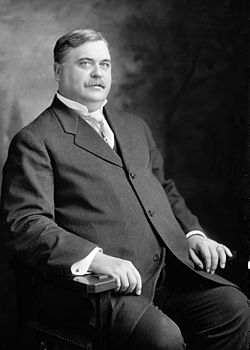Charles Edward Magoon | |
|---|---|
 Charles Edward Magoon | |
| 2nd Provisional Governor of Cuba | |
| In office October 13, 1906 – January 28, 1909 | |
| Appointed by | Theodore Roosevelt |
| Preceded by | William Howard Taft |
| Succeeded by | José Miguel Gómez (as President of Cuba) |
| 2nd Military Governor of Panama Canal Zone | |
| In office 1905–1906 | |
| Appointed by | Theodore Roosevelt |
| Preceded by | George Whitefield Davis |
| Succeeded by | Richard Reid Rogers (as General Counsel) |
| 3rd United States Minister to Panama | |
| In office August 7, 1905 – September 25, 1906 | |
| Appointed by | Theodore Roosevelt |
| Preceded by | John Barrett |
| Succeeded by | Herbert G. Squiers |
| Personal details | |
| Born | December 5, 1861 Owatonna, Minnesota |
| Died | January 14, 1920 (aged 58) Washington, D.C.[1] |
| Resting place | Wyuka Cemetery Lincoln, Nebraska 40°49′03″N 96°39′53″W / 40.8175°N 96.6647°W |
| Occupation | Lawyer |
| Signature | |
Charles Edward Magoon (December 5, 1861 – January 14, 1920) was an American lawyer, judge, diplomat, and administrator who is best remembered as a governor of the Panama Canal Zone; he also served as Minister to Panama at the same time. He was Provisional Governor of Cuba during the American occupation of Cuba from 1906 to 1909.
He was the subject of several scandals during his career. As a legal advisor working for the United States Department of War, he drafted recommendations and reports that were used by Congress and the executive branch in governing the United States' new territories following the Spanish–American War. These reports were collected as a published book in 1902, then considered the seminal work on the subject.[1] During his time as a governor, Magoon worked to put these recommendations into practice. In summary: Magoon was hugely successful in Panama but criticized for his tenure in Cuba.
- ^ a b "C.E. Magoon Dies" (fee). The New York Times. January 15, 1920. p. 11.